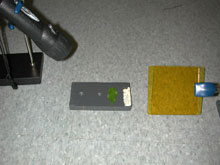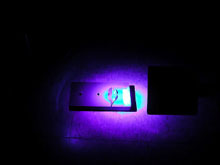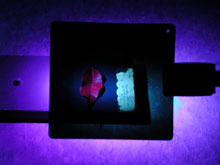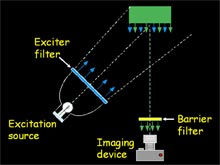
Figure 1: A schematic of the equipment required to detect fluorescence. Click image for larger view and image credit.
Detecting Fluorescence: Green, Yellow, Orange, and Red in the Deep Sea
Charles Mazel
Physical Sciences Inc.
What is "florescence"? Simply stated, fluorescence is the absorption of light at one wavelength (color) and its re-emission at a different wavelength, or color. Some things will glow with a new color when you shine the "right light" on them. The right light can differ, depending on the target. Most people are accustomed to seeing fluorescence produced by ultraviolet light, often called "black light" because humans can't see it. For underwater life, though, we have found that blue light is almost always better than ultraviolet for detecting bright fluorescence.
Figure 2: This photo series shows (top) the test setup with blue-emitting flashlight, leaf and label on plastic, and the yellow barrier filter, viewed under white room light. (Middle) The same scene as the white-light shot, with the room lights out and the blue light on the subjects. (Bottom) The yellow filter has been placed between the camera and the subjects to expose fluorescence. The blue has been almost completely eliminated in the area covered by the filter. Click image for larger view and image credit.
Process for Detecting Fluorescence
Florescence can be detected by either eye or camera. In the deep sea, the process for searching for fluorescence applies to both. First, we must first shine a bright blue light on the sea floor. Since all of the blue light that hits the subject is not absorbed, and fluorescence tends to be weak, a bright blue spot is all you will see. We then use a filter to get rid of the blue light that is reflected back, and let only the fluorescence (green, yellow, orange, or red) through to the imaging device, which is either the eye or a camera. The Figure 1 schematic shows what's going on.
Usually, we start with a light source that emits white light, which is composed of all colors. We put a filter (the excitation filter) in front of that so only the blue light comes out. When the blue light reaches a surface it may cause fluorescence, shown as green in Figure 1. What heads back toward the imager is a combination of green fluorescence plus the reflected blue light. We place a yellow filter (the barrier filter) in front of the imager to block the reflected blue and pass only the fluorescence.
The photo series (Figure 2) demonstrates this process. In the top image, we see a scene illuminated by white light. (You can also see the flashlight, but it is not on in this image.) In the middle image, we have turned off the room lights and turned on the blue flashlight. It looks like a blue light on the scene. Finally, in the image on the bottom we put the yellow filter material between the subject and the camera, and we can now see red fluorescence from chlorophyll in the leaf and a bright fluorescence from a paper label.
Preparing the Submersible
Figure 3 shows powerful lights mounted on the front work basket of the Johnson-Sea-Link submersible. In this case, the two lights on the outside have filters that allow only ultraviolet light to pass through, while the two in the middle have filters that let blue light out. The Sea-Link's camera is fitted with a yellow blocking filter (Figure 4).
We mounted the filter in a way that lets us use the submersible's manipulator arm to swing the filter out of the way for taking images illuminated by white light, or to swing it in front of the camera for fluorescence images. The observer in the submersible sphere wears yellow filter glasses so that he or she can see the fluorescence stimulated by the light.
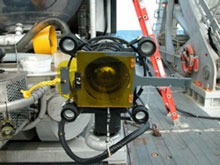
Figure 4: The Johnson-Sea-Link camera is fitted with the yellow barrier filter. In this photo, the yellow barrier filter is swung in front of the camera.
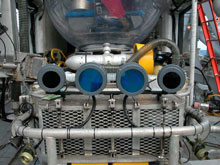
Figure 3: Four 400W HMI lights are mounted on the submersible work basket. The inner two lights are fitted with filters to transmit blue light, while the outer two are fitted with ultraviolet-transmitting filters.
























